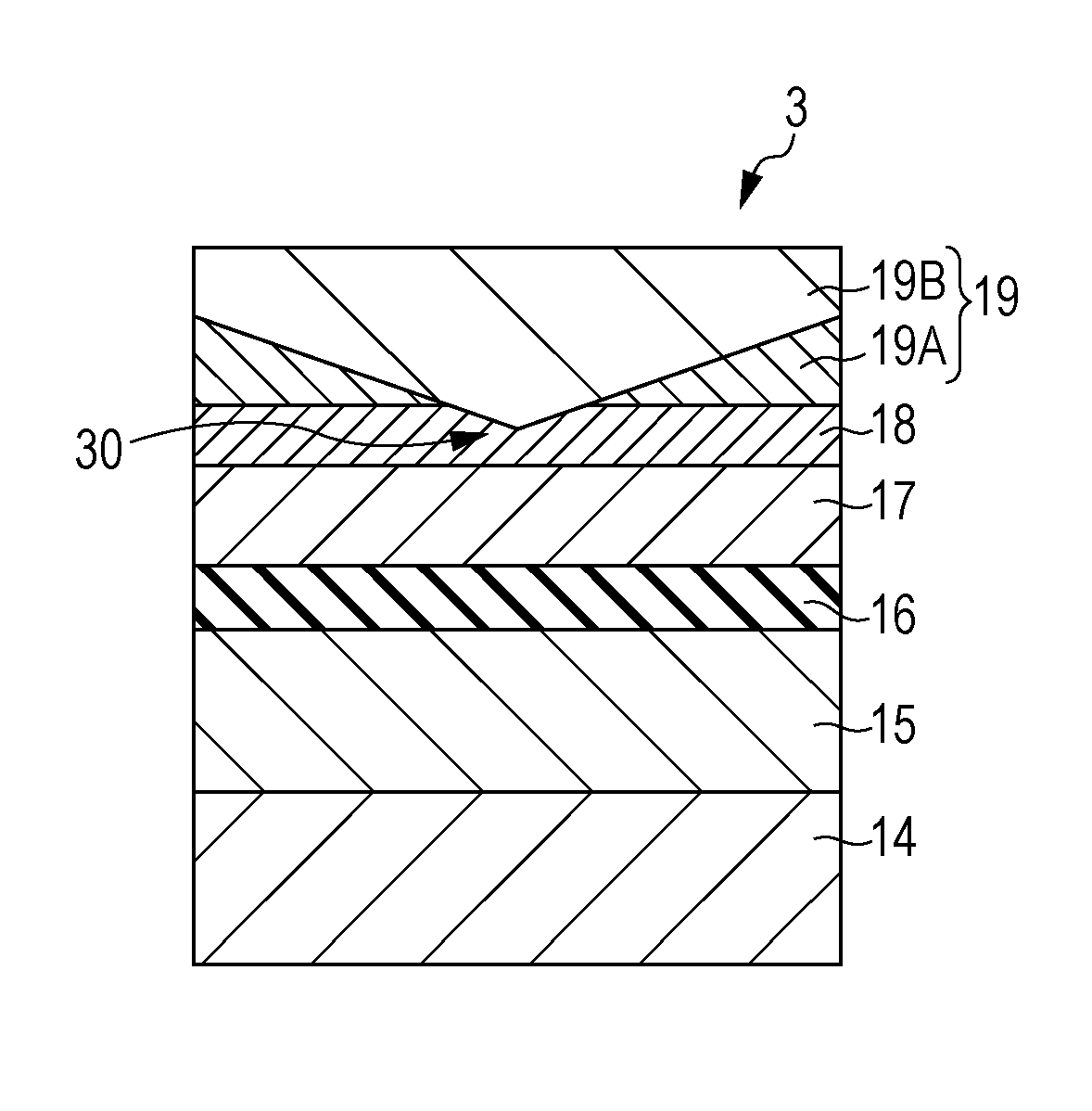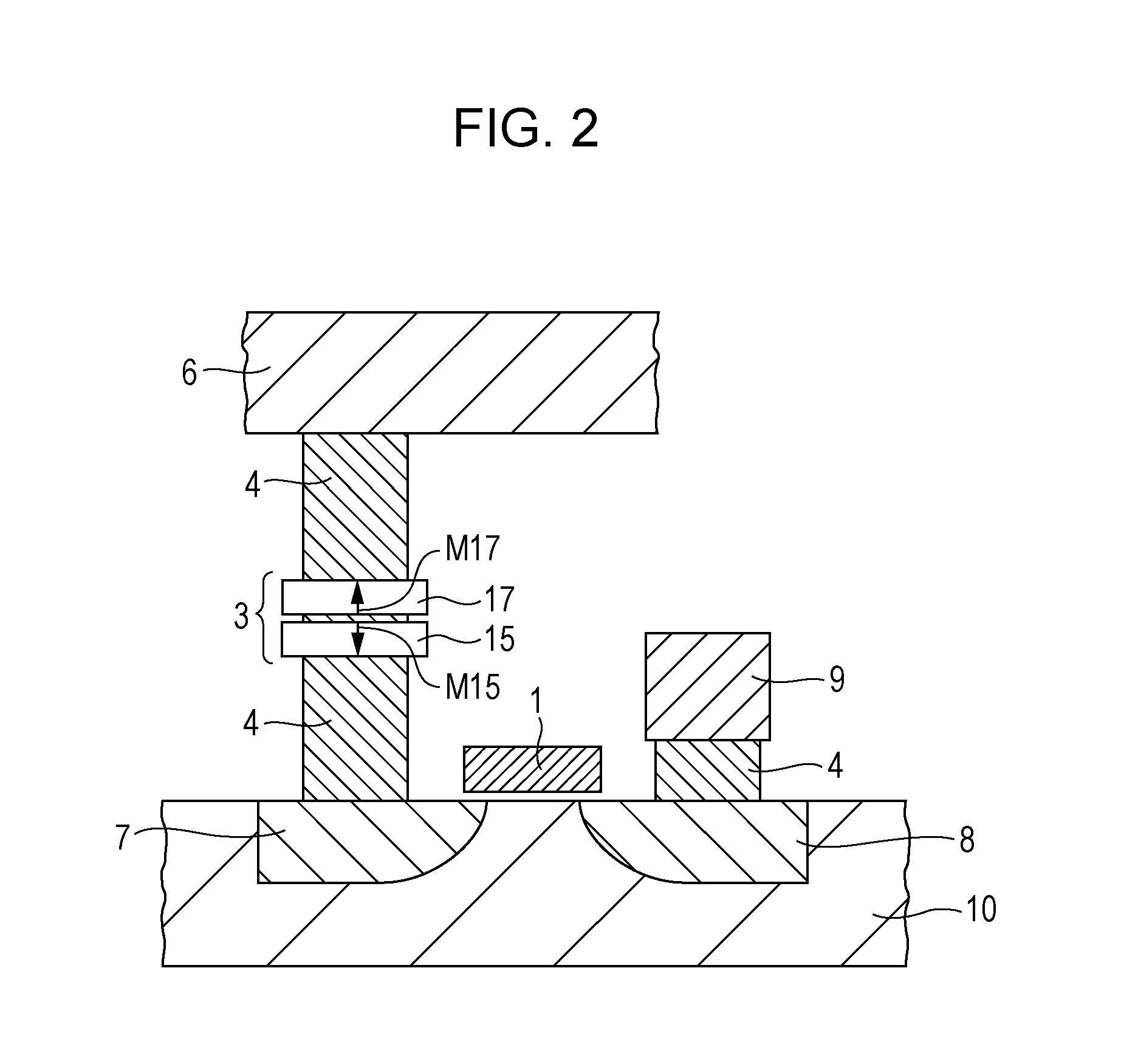Storage element, storage device, method of manufacturing storage element, and magnetic head
a technology of storage elements and magnetic heads, which is applied in the direction of digital storage, magnetic field-controlled resistors, instruments, etc., can solve the problems of reducing the magnetic resistance ratio of the element, difficult storage operation in the range of operation voltages, etc., and achieves effective function, excellent storage characteristics, and low resistance in the element.
- Summary
- Abstract
- Description
- Claims
- Application Information
AI Technical Summary
Benefits of technology
Problems solved by technology
Method used
Image
Examples
first to twelfth embodiments
[0163]Next, a specific configuration of the storage element 3 of the embodiment will be described as first to twelfth embodiments.
[0164]The storage element 3 of the first to twelfth embodiments basically includes an underlayer 14, a magnetization fixing layer 15, a tunnel barrier layer 16, a storage layer 17, a spin barrier layer 18, and an electrode layer 19, similarly to the layer structure shown in FIG. 3B. In particular, by arranging the tunnel barrier layer 16 and the spin barrier layer 18 as oxide layers on both sides of the storage layer 17, the configuration obtains strong interface magnetization anisotropy.
[0165]The spin barrier layer 18 has an effect in which the storage characteristics of information are improved by improving the coercive force of the storage layer 17, and an effect in which the efficiency of the spin torque is improved. Therefore, the spin barrier layer 18 is effective in order to prepare a magnetic memory with low power consumption at a high density.
[01...
second and third embodiments
[0170]FIG. 3A shows the layer structure of the storage element 3 of the first embodiment. As depicted in the drawing, the underlayer 14, the magnetization fixing layer 15, the tunnel barrier layer 16, the storage layer 17, the spin barrier layer 18 and the electrode layer 19 are included. The electrode layer 19, for example, is configured by a first electrode layer 19A and the second electrode layer 19B made from different materials.
[0171]In this case, although the spin barrier layer 18 is formed with a predetermined set film thickness value (for example, a film thickness value of 0.6 nm or more and 0.7 nm or less), a low resistance region 30 is formed in a portion (peripheral region of the film surface) of the spin barrier layer 18.
[0172]In this case, the low resistance region 30 is a region in which the film thickness value of a portion (center region) of the spin barrier layer 18 is a lower value than the set film thickness value, and, more specifically, is a region in which the ...
embodiment
Method of Manufacturing of Sixteenth Embodiment
[0263]Next, the method of manufacturing of the sixteenth embodiment in which the spin barrier layer 18 is formed by etching after etching of the first electrode layer 19A will be described with FIG. 12.
[0264]Since the steps shown in FIGS. 9A to 9F as the fourteenth embodiment are the same, description will not be made.
[0265]After entering the state in FIG. 9F, etching is performed by ion beam irradiation from an oblique direction as in FIG. 12A.
[0266]At this time, if the etching method, type and conditions of gas, and the like are selected so as to selectively etch the material of the first electrode layer 19A, it is possible to remove the end portion of the first electrode layer 19A without excessively removing the spin barrier layer 18, and thereby possible for the spin barrier layer 18 to be exposed.
[0267]Next, etching is performed by ion beam irradiation from above as in FIG. 12B. In this case, the etching rate of the first electrod...
PUM
 Login to View More
Login to View More Abstract
Description
Claims
Application Information
 Login to View More
Login to View More - R&D
- Intellectual Property
- Life Sciences
- Materials
- Tech Scout
- Unparalleled Data Quality
- Higher Quality Content
- 60% Fewer Hallucinations
Browse by: Latest US Patents, China's latest patents, Technical Efficacy Thesaurus, Application Domain, Technology Topic, Popular Technical Reports.
© 2025 PatSnap. All rights reserved.Legal|Privacy policy|Modern Slavery Act Transparency Statement|Sitemap|About US| Contact US: help@patsnap.com



